The effective replacement for the discontinued next step-up GS, the ES, which Lexus claims now places more emphasis on the driver, rides on an adaption of parent company Toyota’s TNGA platform known as Global Architecture-K (GA-K), with a wheelbase 50mm longer than its predecessor, a width gain of 45mm and drop in height of five millimetres.
Measuring 65mm longer in overall length than before, the latest model boasts Lexus’ latest Spindle Grille design dubbed “provocative elegance” by Chief Designer Yasuo Kajino, with a sloping fastback styled rear-end derived from the LS, 17 or 18-inch alloy wheel depending on the model and a bi-tone finish with the mirrors sporting an anthracite hue in combination with the body colour.
Unique to the top-spec SE version is triple-beam bi-LED headlights with integrated daytime running LEDs, folding electric mirrors and a subtle boot spoiler. Speaking of colours, the ES can be had in a choice of nine tones; Black, White Quartz, Mercury Grey, Platinum Silver, Opulent Blue, Morello Red, the new Sonic Titanium, Olive Green and Ice Ecru.
Inside, the ES takes a number of styling cues and touches from the NX and RX, with pride of place going to the new 12.3-inch infotainment system controlled by the Remote Touch touchpad, and the seven-inch TFT instrument cluster display.

While both the entry-level EX and aforementioned SE come fitted as standard with items such as a three-mode Drive Mode Select system (Eco, Normal and Sport), Concierge Service and a tilt-sliding/opening sunroof, the latter model adds a wood trimmed heated steering wheel, four-way lumbar support for the front seats as opposed to the EX’s two, colour Heads-Up Display, front and rear heated chairs, rear window blinds, a smartphone charging pad, Semi-Aniline leather, wood detailing, surround view camera system and a 17-speaker Mark Levinson sound system.
Aside from the standard array of safety systems, including the fitment of ten airbags on both models, the ES also comes with Lexus’ Safety System+, which for now is only available on the SE with tech such as Adaptive Cruise Control, Lane Keeping Assist, Blind Spot Monitor, Pre-Crash Assist with Pedestrian Detection, Lane Departure Warning and Adaptive High Beam Assist.
Equipped with a new multi-link rear suspension, adaptive shock absorbers known as Dynamic Control Shocks, wider anti-roll bars and a rack-mounted electric power steering system as part of the changes underneath, the ES will go on sale with a choice of two engines and two transmission options.

In EX guise, the ES comes powered by a normally aspirated 2.5 that produces 152kW/243Nm, mated to the new eight-speed Direct Shift automatic gearbox with paddle shifters. Claimed to consume unleaded at a rate of 6.6-litres/100km, the ES 250 will complete the 0-100km/h sprint in 9.1 seconds and top out at 210km/h.
At the sharp-end, and with the ES 350 in F-Sport guise a no-no for now, the SE comes outfitted with the same engine as the EX, but adds an electric motor to create the ES 300h with a combined system output of 160kW. Hooked to a CVT, Lexus claims a top speed limited to 180km/h and 0-100km/h in 8.9 seconds, with fuel consumption being rated at 4.6-litres/100km.
Now standard on all Lexus model, the ES comes with a seven year/105 000km warranty and maintenance plan, with the ES 250 EX being priced at R593 300 and the ES 300h SE at R843 800.
















